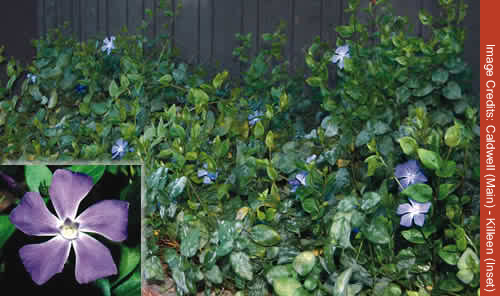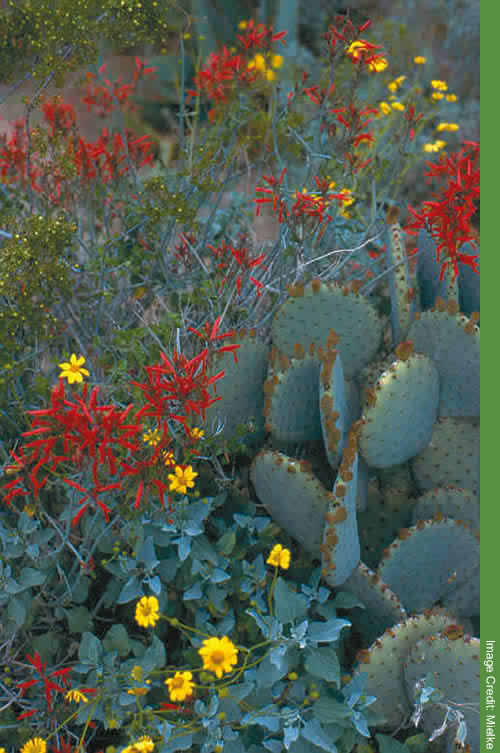

The Sonoran Desert inspires gardeners throughout southeastern Arizona, but there are challenges to desert landscaping. We want hardy plants that use little water and can stand up to blazing heat and dryness, while providing reliable blooms, striking architecture, shade, and lush growth. We also desire plants that attract hummingbirds, butterflies and songbirds. Hundreds of plants from other arid regions have been made available to us. Some of these introduced plants have adapted so well that they have escaped from yards and are invading Arizona’s natural areas. These introduced plants grow and spread aggressively, crowding out native plants. When this occurs, these plants are considered to be invasive.
Often, invasive species don’t reveal themselves immediately. They may seem to be well-behaved landscape plants for decades. Eventually a few adapt to natural areas. Once adapted, the invasive plant’s population explodes. Without prompt action, invaders may overwhelm an ecosystem. Such is the case with fountain grass. Introduced as a graceful ornamental and widely planted, it disperses by seed and spreads into canyons, washes and along roadsides. It not only crowds out natives, but also dries into flammable fuel. Unlike native desert plants that are often killed by hot fires, fountain grass re-sprout quickly after a burn and can dominate a landscape and fueling even larger fires.
 Southeastern Arizona boasts a wealth of interesting native plants for creating a diverse, colorful and vibrant garden. Native plants are well adapted to our desert climate, come in a wonderful spectrum of colors and shapes, and provide excellent habitat and forage for wildlife. Because native plants have evolved locally, many can survive with little water. Thus growing natives can save you money and help conserve a scarce resource. The native alternatives we recommend are not intended to be exact replacements but rather are suggestions of plants that fill a similar functional role in a landscape, thrive in similar environments as the pest plant or are similar in appearance.
Fortunately, most non-native plants do not threaten natural ecosystems. This
website features only those pest plants with known detrimental impacts on southeastern Arizona’s wildlands and are available commercially. Other non-native plants have escaped cultivation, but their ecological impacts and invasiveness are uncertain. However, finding a non-native plant in natural areas is a clue it has the potential to become invasive.
Southeastern Arizona boasts a wealth of interesting native plants for creating a diverse, colorful and vibrant garden. Native plants are well adapted to our desert climate, come in a wonderful spectrum of colors and shapes, and provide excellent habitat and forage for wildlife. Because native plants have evolved locally, many can survive with little water. Thus growing natives can save you money and help conserve a scarce resource. The native alternatives we recommend are not intended to be exact replacements but rather are suggestions of plants that fill a similar functional role in a landscape, thrive in similar environments as the pest plant or are similar in appearance.
Fortunately, most non-native plants do not threaten natural ecosystems. This
website features only those pest plants with known detrimental impacts on southeastern Arizona’s wildlands and are available commercially. Other non-native plants have escaped cultivation, but their ecological impacts and invasiveness are uncertain. However, finding a non-native plant in natural areas is a clue it has the potential to become invasive.
The complexity of our environment precludes us from accurately predicting which non-native plants will become aggressive and invade natural environments. These potential invaders start by spreading in urban and disturbed areas. Therefore, it is up to us, as consumers to be responsible gardeners and choose native plants for our landscapes. Native plants benefit wildlife and help preserve species diversity.
Removing pest plants from urban areas is expensive and often seems impossible. By limiting new introductions we can eliminate additional sources of seeds. When landscaping adjacent to natural areas, use local native plants. The suggested alternatives are widely used and readily available, some may be easier to find in specialty or native plant nurseries.
